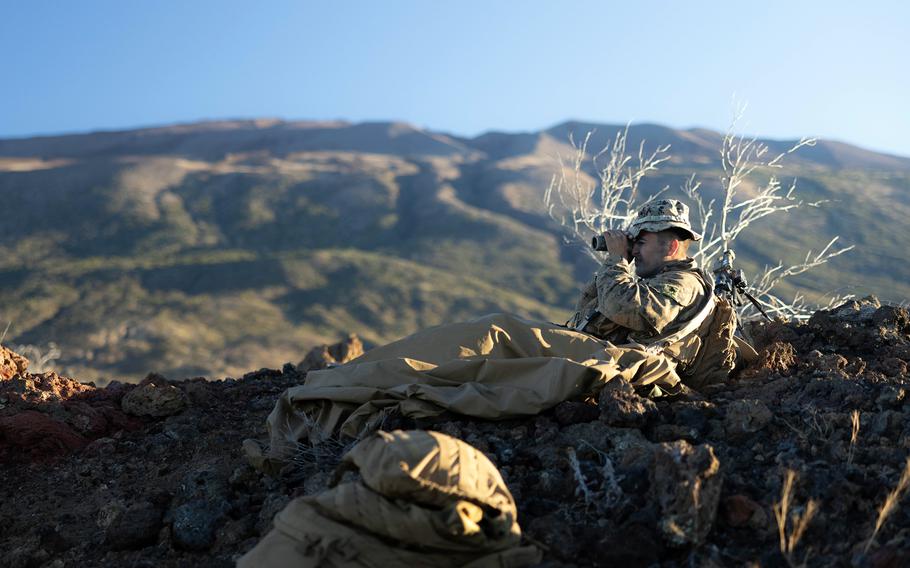
A member of the 3rd Marine Division observes his fire sectors during an Army-led exercise at Pohakuloa Training Area, Hawaii, in November 2023. (Eric Huynh/U.S. Marine Corps)
FORT SHAFTER, Hawaii — The Army is proposing renewing a lease for almost 20,000 acres of state land on Hawaii’s Big Island, despite the conclusion of an environmental assessment released Friday that such use could adversely impact Hawaiian cultural practices and environmental justice.
The Army is seeking renewal of its lease for state land within Pohakuloa Training Area, a 132,000-acre live-fire training range made up of mostly federally owned land.
The state granted the Army a 65-year lease in 1964 for 23,000 acres, and the Army has sought to renew the lease ahead of its expiration in 2029.
The Army is proposing a lease renewal for 19,700 acres, roughly 14% less land than the original lease, according to the assessment.
In April 2022, the Army released a draft environmental impact statement that considered several lease alternatives, from retaining the full 23,000 acres to leasing as little as 10,100 acres.
That impact statement did not offer up a preferred alternative by the Army, but it did conclude that none of the alternatives posed significant adverse impacts to the environment.
The lease renewal has faced opposition from local activists who say the Army has not properly maintained the state land as required under the lease and argue more broadly that the U.S. military’s footprint covers too much of the state.
A Hawaii judge in 2018 ruled that state officials had failed to ensure the Army maintained the range and protected Hawaiian cultural interests — as required in the lease — in a lawsuit filed by Native Hawaii cultural practitioners.
An online petition calling on Hawaii’s governor and the board of the Hawaii Department of Land and Natural Resources to not renew the lease had more than 9,769 signatures as of Friday.
The Army received hundreds of responses during a public comment period in 2022 concerning its draft statement, which were incorporated into and published with the just-released assessment. Many of those comments focused on concerns about land use, biological resources, cultural practices and hazardous substances.
The Army maintains that the Pohakuloa Training Area, including much of the leased state land, is crucial to the nation’s security.
“The geographical location of Hawai‘i is a strategic one for national defense and rapid deployment of military forces, and the island plays a key role within the U.S. Indo-Pacific Command area of responsibility to help achieve U.S. national security objectives and protect national interests,” the second impact statement states. “PTA is the only Army Major Training Area in Hawai’i, making it the Army’s primary ground maneuver tactical training area supporting home-station, joint, and multinational training in the State.”
Other service branches use the training area, particularly Oahu-based Marines.
If granted the lease renewal, the Army proposes adopting mitigation measures to counter the findings of significant adverse impact regarding Hawaiian cultural practices, land use and environmental justice.
For example, the Army would formalize a request process that would enable Native Hawaiians and cultural practitioners to promote and preserve practices and resources.
The Army would also “explore options to provide unlimited cultural access to specific locations to be determined in consultation with Native Hawaiians and cultural practitioners,” the environmental assessment states.
The Army is soliciting public comment on the second environmental assessment through June 7. It can be found at https://home.army.mil/hawaii/index.php/PTAEIS.
Written comments can be emailed to atlr-pta-eis@g70.design or mailed to ATLR PTA EIS Comments, P.O. Box 3444, Honolulu, HI 96801-3444.